
Andre Pillay Perfume III via Saatchi
The transformative power of perfume intimates itself time and again throughout one’s lifetime, whether through the choices we make and don’t make – or those scents we crave which reveal desire, unmet deep-seated needs. It isn’t happenstance that many who suffer from depression repeatedly seek out citruses, as I’ve observed for the past 50+ years – or that one of the significant signs of dementia is a definite decrease in olfactory acuity.
Our sense of smell is indisputably primal: a seat of powerful memory, scent as immediate recall and recognition. The most ancient part of our neuroanatomy, the archipallium – is our primitive reptilian brain. It includes among other structures, the olfactory bulbs. Potent perception resembles the two faces of Janus, a double-edged sword: one cannot shut it off, yet this increased sensitivity may be harnessed for diagnostic and therapeutic effect. I first insisted that patients who were in pain secreted a unique odor, and that those who were fearful also secreted other distinct odors which I detected over 40 years ago while working at Boston’s Massachusetts General Hospital. My observations were greeted with considerable bemusement by my neuroendocrine colleagues at that time, who claimed that no such relationship existed. Today this is accepted as medical fact.
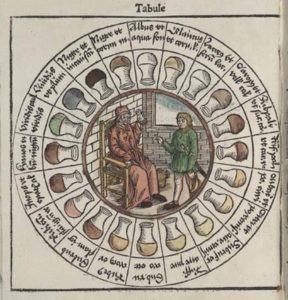
Via viralnova.com Medieveal doctors using urine specimens to determine aliments
In medical practice as in everyday life, odors are revealing. Before we had access to more sophisticated diagnostic studies, physicians smelled their patients: their breath, their skin and bodily fluids. Each had its own tale to tell, were one predisposed to listen with a learned nose. I often remark to my patients: “Cure? Whether or not there can be cure – healing is always possible.”
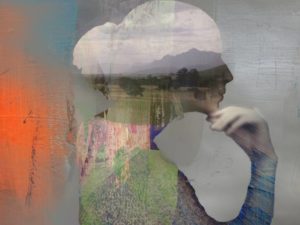
I’d like to share how I’ve utilized fragrance in the care of my patients over the past decades. Here are three very different cases where the specific employment of perfume-as-medicine (something in which I fervently believe) has contributed to the overall healing of those entrusted to my care. The human spirit needs feeding and nurturing as well; therapeutic touch, music and humor where appropriate amplify aroma’s positive effects by incrementally layering loving intention.
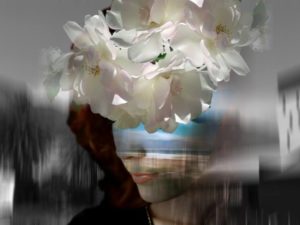
I was assigned to nurse a ninety-six year old Greek woman, Mrs. T, who was severely impaired physically and could only communicate by stroking, patting, or gesticulating with her right hand. She vocalized periodically but not intelligibly – and her English was non-existent, so our communication was primarily sensory in nature. This lovely woman had a devoted daughter and sons who kept a continuous bedside vigil and acted as translators for me in a pinch. It was they who told me about her garden back home, how dearly she missed it – especially her gardenias, which were her favorite flower. She lamented the loss of her gardenias above all the other changes to which she had to accommodate when moving to America to live with her grown children and grandchildren
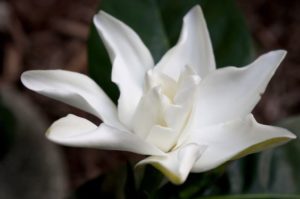
Gardenia for Enfleurage by Elise Pearlstine
What is like a real gardenia? I had sequestered a very small jar of Laurie Stern of Velvet and Sweet Pea’s Purrfumery’s rare Tuberose and Gardenia Enfleurage Face & Body Whipped Frosting: the enfleurage alone takes well over a year to produce, then is combined with luxurious oils suitable for massage, even for delicate complexions. I went home, scooped out some and brought it in the next day. While I bathed her, I tenderly massaged her face with the gardenia-infused cream, much to her delight. How do I know this? Because she began to moan with pleasure, her facial features arranged blissfully. She rolled her eyes back and grabbed my arm, stroking it over and over, sighing deeply. She reached for my hand and squeezed it tightly, reluctant to let me go. I was genuinely thrilled that such a simple gesture could make her happy.
When you consider that gardenia jasminoides (G.grandiflora) indeed possesses a similar compound to jasmines which mimics the effects of Valium without the 96-hour half-life and side effects, it makes a great deal of sense. GABA, the fear and anxiety neurotransmitter/chemical messenger – serves to help control overexcited neurons; benzodiazepine medicines such as Valium and Librium are frequently utilized to calm the jangled nerves. Science backs up what seems evident to us.

Table Mountain Journal by Andre Pillay©
I am close with an Indian pharmacist, Mr. J, with whom I’d bonded many years ago. He is a shining beacon of goodwill to all he encounters – but of late, he’d been homesick as I’d never seen him before. He was telling me about his horticultural exploits (we share a love of plants and flowers), which brought back memories of his beloved grandfather, a brilliant horticulturalist back home who had passed away. He explained that his grandfather was the kindest man he’d ever known.

His grandfather always smelled like the fresh rain, especially the way the earth smells when the monsoon occurs and the land is flooded with water; the rains used to come all the way up to the windows of the house, and he longed to smell him again. I told him I thought I understood and that I had something for him to smell… just two milliliters of something which I could share. Sadly I could only part with a few drops; and when I visited him the next day – I’d bring it.

Mitti via National Geographic
I was very excited, because my best educated guess was that that his grandfather smelled of mitti attar, the distillation of the essence of parched earth with fine quality sandalwood oil. I didn’t have much, but I suspected that it would be a good fit. I had purchased it from White Lotus Aromatics. The next day, my friend opened his tiny glass vial with joy: mitti was indeed the scent of grandfather, and it brought tears to both of our eyes. “Now whenever you miss him, a part of him will always remain near,” I whispered.
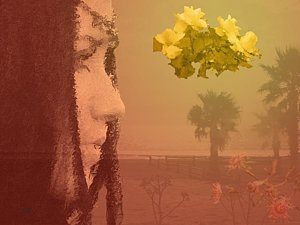
Fragile Beauty by Andre Pillay via Saatchi Art©
My work with Miss S has to be one of my favorite experiences because of the eventual marvelous outcome for my patient in spite of the cards being staunchly stacked against her. This very young woman had undergone extensive surgery, with horrific results. Everything that could have possibly gone awry did – and then some. Due to extreme nutritional deficits over time, she found herself growing weaker until she could no longer use her arms or legs, feed herself or perform any activities of daily living. She most understandably became obstreperous and difficult to manage due to her dire circumstances and burgeoning fury. Miss S was a handful.

Most days she would refuse medicines, foods, demand a variety of minutiae purely as a coping mechanism and a way to reclaim some control over her devastating life. I happen to enjoy challenges, young women with wits, and feel for those who’ve not had particularly loving rearing in the first place. My sullen charge was tailor-made for me, and I good medicine for her, it seems. Was her favorite color purple? I entered her room as the lead singer from Gogol Bordello and sang “Start Wearing Purple, Wearing Purple” in my best Ukrainian accent.
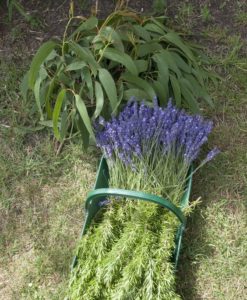
Lavender by Elise Pearlstine
Lavender was Miss S's favorite scent. The fragrance I chose for her had to be genuine, delicate and suitable. I had recently purchased a bottle of L’Artisan Parfumeur’s Bucoliques de Provence; it was just the ticket. She felt calmer, more confident and optimistic. What I realized was that Miss S needed to feel like a person, smell beautiful and feel attractive, as any young woman would want.
Once again, science confirms what we see at the bedside: Linalool 1 and Linalyl Acetate 2 are the main constituents of lavender oil; not only are they delightful in perfumery, they have been studied scientifically as well. Is there an end to the tale? It’s a beginning, really – she finally was able to walk, use her hands, marry the love of her life and find a job. She didn’t lose faith, worked harder than most people I know, and surmounted obstacles that would have felled someone else.

For those of us who cherish the benefits and opportunities for healing which olfaction bestows, the sudden loss of our fifth sense would leave us despairing. I have found many uses for scent in my hospice care, with the terminally ill and other patients. I believe that fragrance is one of the tools in our therapeutic arsenal – to be applied wisely, with loving intention. Sometimes perfume feels transformative, and perhaps it is.
-Ida Meister, Senior Editor
Art Direction: Michelyn Camen, Editor-in-Chief
